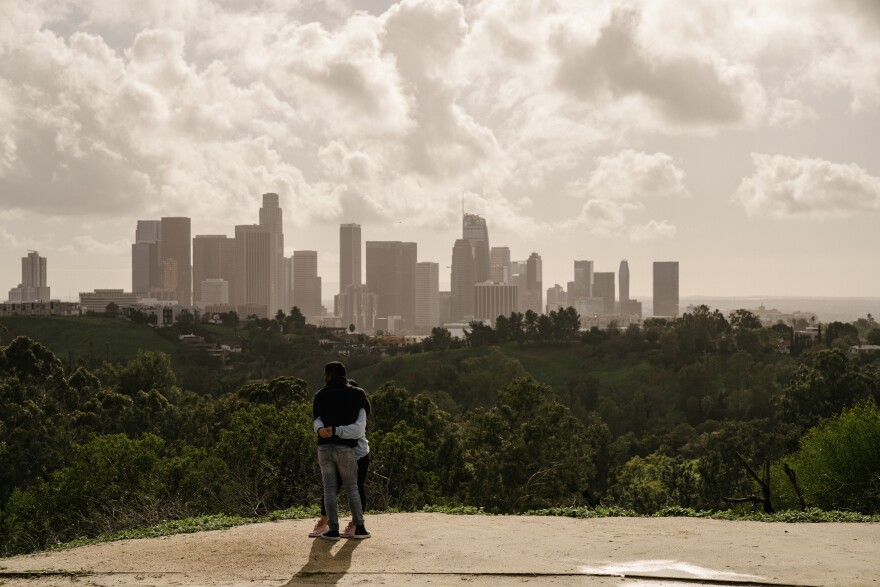Why 'Abnormal Is Normal' When It Comes To Weather In Southern California

Every 90’s R&B fan worth their salt should know Tony! Toni! Toné so I am not gonna be shy about leading with one of the band’s most recognizable songs It Never Rains (In Southern California). It. Is. A. Jam. But I don’t know what possessed the songwriter to pen these lyrics, because, as we definitely found out these past few weeks, it not only rains in Southern California, it pours.
Is This Wet Weather Normal Or Not?
Now, I know I said I wouldn’t talk about the weather for a while but my How to LA colleague Brian De Los Santos had a chat with a climate scientist recently that really puts some perspective on the deluge we’ve just experienced in California. This record rainfall and flooding has been quite scary for a lot of people, and it has prompted a lot of questions about why we had so much of it. Are we headed towards the apocalypse? Or…could this possibly be normal?
The answer is, of course, not exactly straightforward. In Southern California, says Alex Hall, a professor in the Atmospheric and Oceanic Sciences Department at UCLA, “abnormal is normal.”
-
This is the web version of our How To LA newsletter. Sign up here to get this newsletter sent to your inbox each weekday morning
“The precipitation here in California is incredibly variable,” Hall says. “It's the most variable precipitation in the whole country, so we have these bonanzas sometimes, and then we have these really, really dry times.”
Rarely, he says, is there an “average" weather year.
So, the rainfall we’ve perceived as abnormal weather is normal. But does climate change play a part here? Yes, it does, Hall says. He explains that our warming world is likely making these storms more intense because warmer air holds more moisture. But the bigger issue is that the rain doesn’t fall as snow as much as it once did, which leads to greater flood risk.
One main reason why, he says, we need to reduce greenhouse gas emissions drastically. State officials already set a bold plan in motion to cut gas emissions in half in this decade and to eliminate carbon emissions completely by 2045.
If you’d like to hear all of Hall’s conversation with Brian, including his credit card analogy for why we still aren’t out of a drought, despite all the rain, you can listen to the latest podcast episode of How To LA.
As always, stay happy and healthy, folks. There’s more news below — just keep reading.
More News
(After you stop hitting snooze)
- COVID-19 eviction protections are set to expire after Jan. 31 but the Los Angeles City Council is looking for ways to keep renters housed. It is expected to vote on a package of new policies this week.
- Los Angeles Police Chief Michel Moore has banned “Thin Blue Line” flags from station lobbies, uniforms and cars, citing that it’s been “hijacked” by extremists. The police union has expressed outrage over the move.
- Following the deaths of three men, L.A. city council members on Tuesday joined Black Lives Matter co-founder Patrisse Cullors to call for unarmed responses to people experiencing mental health crises.
- Housing problems still persist for University of California graduate students. About 21% of UC’s students are in graduate programs but only 15% of housing is reserved for them — and the number of beds might be a lot fewer depending on the campus.
- Elon Musk is on trial for allegedly using Twitter to commit fraud. NPR has all the details about the Tesla buyout tweets, the trial and what’s at stake for Musk.
- Doctors and faculty within the University of California’s health system want better protections in their contracts with faith-based hospitals for when they have to perform treatments like abortion, when deemed suitable.
- One of my absolute favorite things to do with my nieces (or even on a date!) is going to a museum I’ve never been to before. On February 5, 30 museums in Southern California are allowing visitors to enjoy their collections for FREE. You know I love the sound of that. Make sure you take advantage of that day!
-
*At LAist we will always bring you the news freely, but occasionally we do include links to other publications that may be behind a paywall. Thank you for understanding!
Wait... One More Thing
How The Destruction Of LA's Original Chinatown Led To The One We Have Today

Ever since I was little, I’ve been fascinated by L.A.’s Chinatown, especially Central Plaza. But I never knew any of the history that came with it. So, today, I want to take you with me to Downtown L.A. in the mid-1800s, near Olvera Street, where the city’s first Chinatown once stood.
Back in the 19th century, Chinese migrants, like so many others, came to the United States for better opportunities. Many of them settled in L.A. near what is now known as the birthplace of Los Angeles, El Pueblo de Los Angeles Historical Monument. However, just like many racial/ethnic groups in America, they faced discrimination, harsh negative stereotypes and degradation.
The built up tension and racism eventually led to one of the worst massacres in U.S. history. Roughly 18 Chinese people were robbed, beaten and killed by a violent mob in 1871. Still, more Chinese moved to the area and managed to make do and expand, starting businesses and organizations.
The community grew and flourished but eventually the allure of prime real-estate and a rail line led to the demise of Old Chinatown. The construction of Union Station forced the eviction of many Chinese residents. Today, very little of the old community exists.
So how did the New Chinatown sprout up and who was a part of it? A man named Peter Soo Hoo, the first Chinese American engineer hired to work for the Department of Water and Power. Learn about him and how New Chinatown came to be with the opening of Central Plaza in 1938.
There’s such a rich history of Chinatown. Read more about it in Liz Ohanesian’s article. It’s time for me to take another visit!
-
Got something you’ve always wanted to know about Southern California and the people who call it home? Is there an issue you want us to cover? Ask us anything.
-
Have a tip about news on which we should dig deeper? Let us know.




